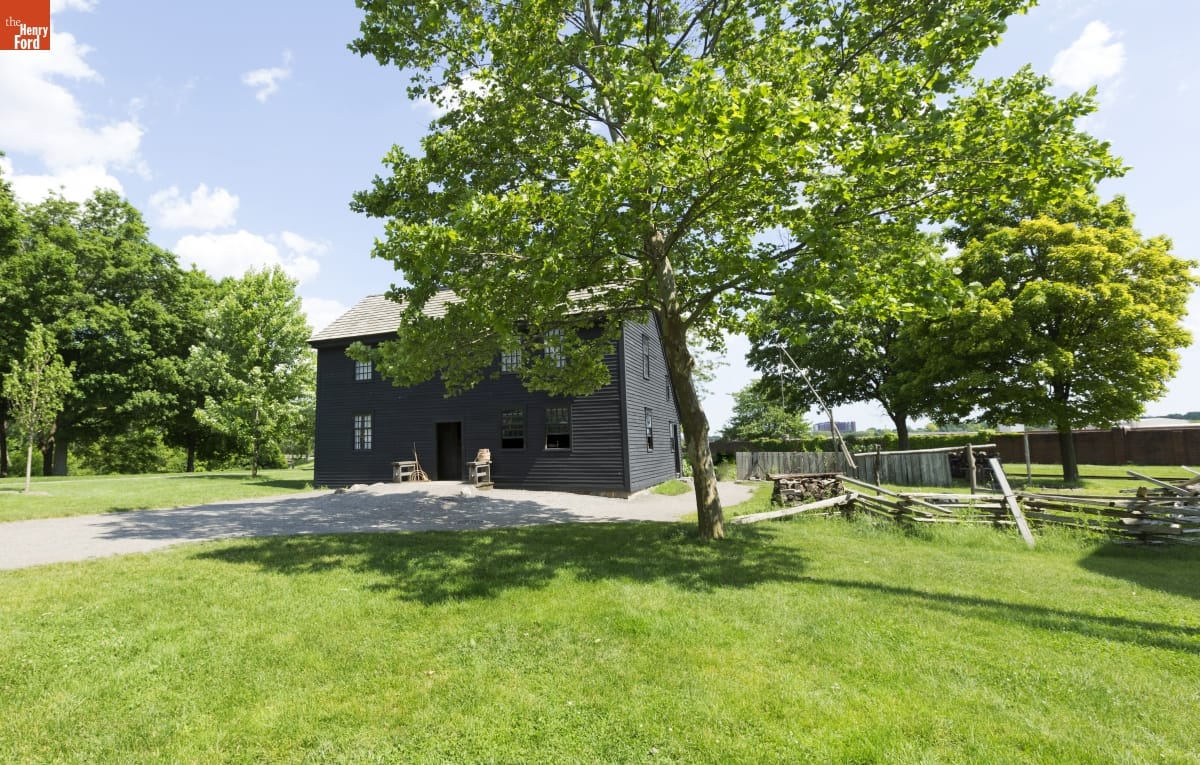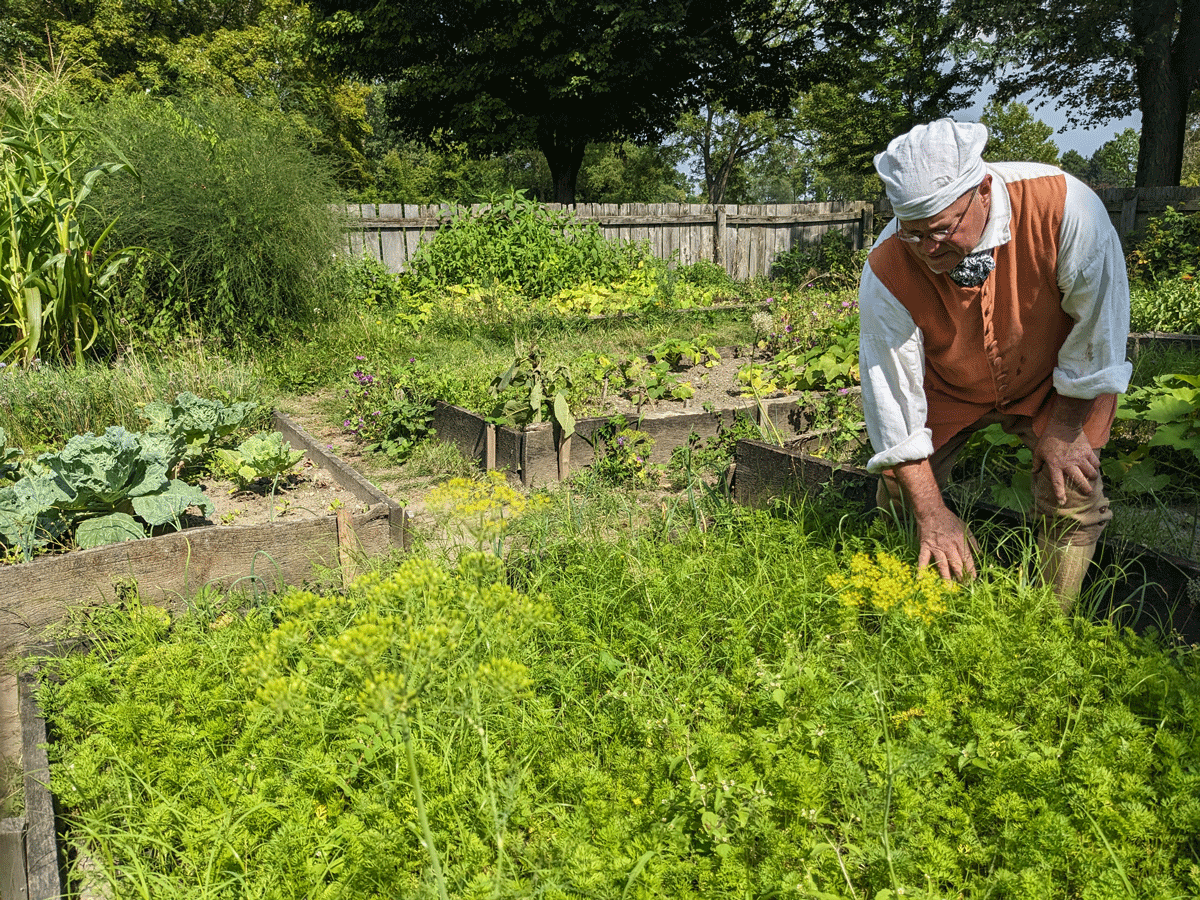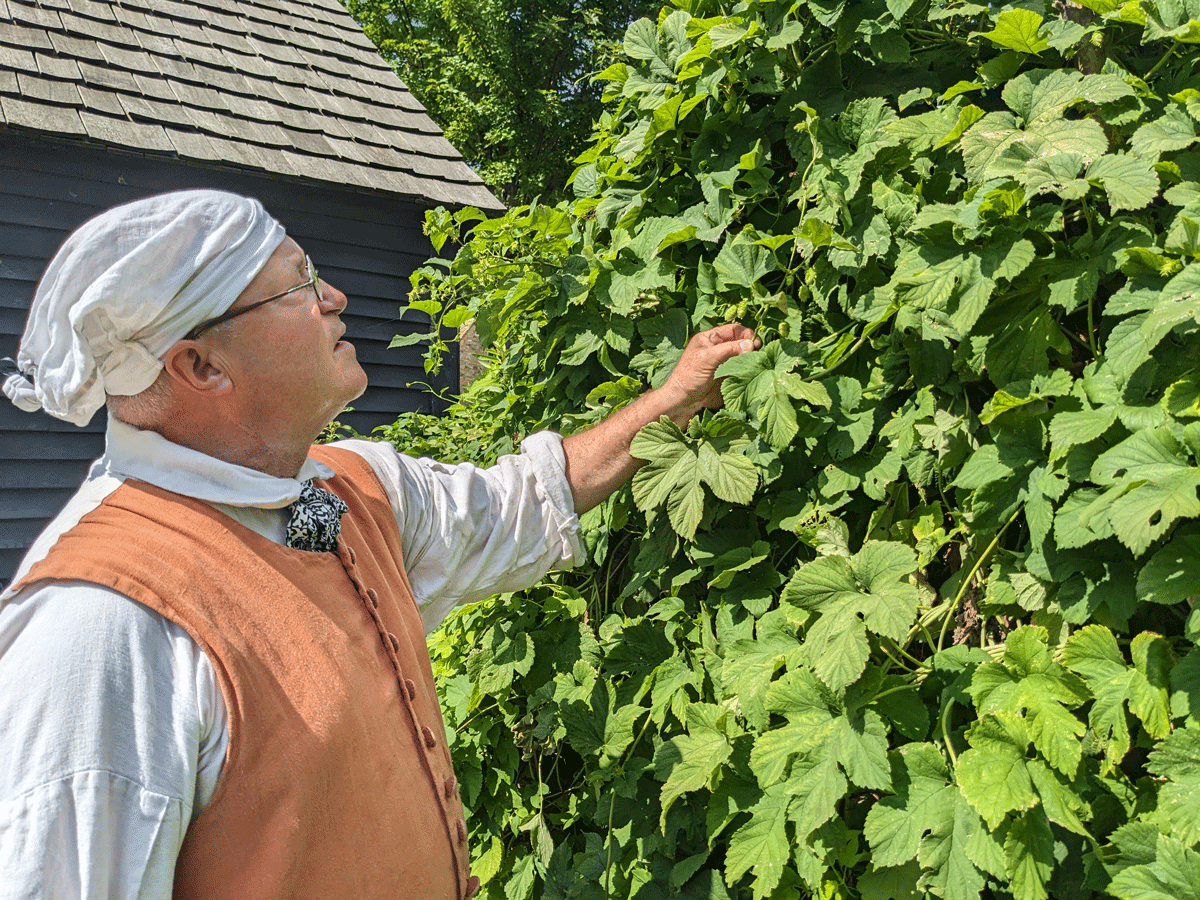Monthly Archives: November 2023
Preserving the Fruit and Vegetable Harvest at Daggett Farm

Daggett Farmhouse in Greenfield Village. / THF175173
Samuel and Anna Daggett and their children, like other farm families living in northeastern Connecticut in the 1760s, made careful preparations to get through the winter. Food was a year-round concern and a top priority, especially in the fall, as the family preserved a supply of meat, harvested crops and took special care to prepare and store fruits and vegetables to last the colder months.
The Daggetts kept pumpkins and other winter squash in their house cellar or attic to prevent freezing. They stored a variety of hardy root vegetables in an outdoor root cellar — essentially a stone-lined pit dug into the earth, preferably into a small hillside, and lined with stones for additional insulation and cleaner storage. A wooden cover or door lined with straw provided access throughout the winter. In addition to turnips, potatoes, beets and similar vegetables, the Daggett family stored cabbages — pulled roots and all — in the root cellar. They left other root vegetables, like parsnips and salsify, in the frozen ground of the garden and dug them out as needed.

Presenter with carrots in Daggett Farmhouse garden, early August 2023. / Photo by Debra A. Reid
The family left beans and peas to fully mature on their vines or stalks in the field. Once completely dry, they pulled and laid the plants on a flat surface, then hit them with a wooden tool called a flail to break the pods apart. The Daggetts gathered the loose beans or peas and cleaned them by a process called winnowing, flipping them up and down in a large shallow basket as the breeze blew away dust and debris. They then packed the beans and peas in sacks and stored them away in cool, dry locations around the house until it was time to wash and cook them. The family also dried green beans, which could be reconstituted and used as a welcome addition to soups and stews in the winter and early spring, when no fresh green vegetables were available.
With careful planning, all sorts of vegetables would meet the family’s needs until produce became available again. It’s no wonder that the first early greens from the garden were so looked forward to after a winter of starchy root vegetables!
Much of the fruits grown and used by the Daggett family — especially apples but also perhaps pears, peaches, cherries, quinces and grapes — could also be carefully preserved for the winter. The Daggetts had very limited technology when it came to “canning” as we know it today, but they did keep fruit jams or preserves in small earthenware crocks sealed with beeswax, spirit-soaked parchment or animal bladders. They also sliced fruit and laid it flat in baskets or wooden racks to dry. Some fresh fruit could be kept whole, carefully packed in barrels and stored in one of the rare cool spots around the house.
Samuel Daggett pressed apples using a large, animal-powered machine. The family fermented the sweet juice of the crushed apples into hard cider, which could be stored in barrels for use throughout the winter, and made cider vinegar and applejack, a kind of apple brandy. The Daggett farm produced enough cider to meet the family’s needs and even some extra to sell to the surrounding community. Other beverages that kept well included perry (fermented pear juice), wine made from grapes and beer brewed with hops from the garden.

Presenter with hops at Daggett Farm, early August 2023. / Photo by Debra A. Reid
Today at Daggett Farm in Greenfield Village, as in 1760s New England, the slower pace of long summer days begins to quicken as the harvest season approaches. If you visit in the fall, you may see the staff harvesting and storing away a variety of garden produce, much like the Daggett family did.
Jim Johnson is The Henry Ford's curator of historic structures and landscapes and director of Greenfield Village. This post was adapted for the blog by associate curator Saige Jedele.
Conserving the Desk That Helped Tell Ulysses S. Grant’s Story

Background shows a sneak peek of the conservation treatment of Gen. Ulysses S. Grant’s desk. / Image of Grant writing his memoirs in July 1885 courtesy of the Library of Congress.
The Henry Ford has quite a collection of objects used by historical figures on display. There are many more gems safeguarded in storage with equally fascinating stories. One such piece is Army General and 18th U.S. President Ulysses S. Grant’s secretary desk. Henry Ford was interested in collecting items tied to people he admired. That is why he purchased Grant’s desk from renowned antique dealer Israel Sack of Boston, Massachusetts, in 1930. The desk had passed down through the family of Grant’s wife, Julia, before making its way to the former president. Grant used this desk while writing his “Personal Memoirs” in 1884 and 1885. Recently, the desk has made its way to the museum’s conservation lab for a bit of TLC and a taste of the limelight.
Continue ReadingWomen and the Working Farms of Greenfield Village

Sally Ann Firestone with her grandchildren at their farmhouse in Columbiana County, Ohio, circa 1876. / THF115221
How should we answer the question, “Did women do farmwork?” In the time periods and regions interpreted at the working farms of Greenfield Village — here we examine the Daggett, Firestone and Mattox family farms — men typically worked in the fields and barnyards, and women worked in and around the farmhouse. (This contrasted markedly with Indigenous American and African cultures that operated with a matrilineal worldview and in which women had authority over farm work. Women in these cultures worked fields and processed, preserved and stored food.) Because of this gendered division, some argue that only men truly did farmwork. However, farmwork ebbed and flowed between fields and barnyards and the farmhouse. In the farmhouse and surrounding yard, women nursed orphaned livestock, started seeds, preserved food, discussed farmwork and market strategies, and prepared meals three times every day to maintain their family’s health. Everyone did farmwork, and no one found relief from it.
Continue ReadingWhen Black Women Worked from Home

Mattox Family Home in Greenfield Village, 1991. / THF250591
Starting in the Reconstruction Era, multiple generations of the Mattox family would live in the Mattox Family Home, a farmhouse located in Bryan County, Georgia. At a time and place when African American land ownership was rare, the Mattox family was able to farm their own land into the 1930s when the family was led by Amos and Grace Mattox. Grace Mattox’s story gives us a unique glimpse into what labor looks like for an African American woman and her family just one generation removed from slavery.
To be an African American woman working in agriculture, to tend a crop or to look after livestock was not new — the labor of entire African American families was used for generations by plantation owners looking to get wealthy from cash crops. Looking at Grace Mattox’s life, we can see what farming looked like without that layer of economic exploitation. What did farming mean for an African-American family that owned their own land instead of sharecropping? Or who farmed to put food on the table rather than to turn a profit? What changes when the person doing the farming gets to benefit from their own labor?
Continue Reading
